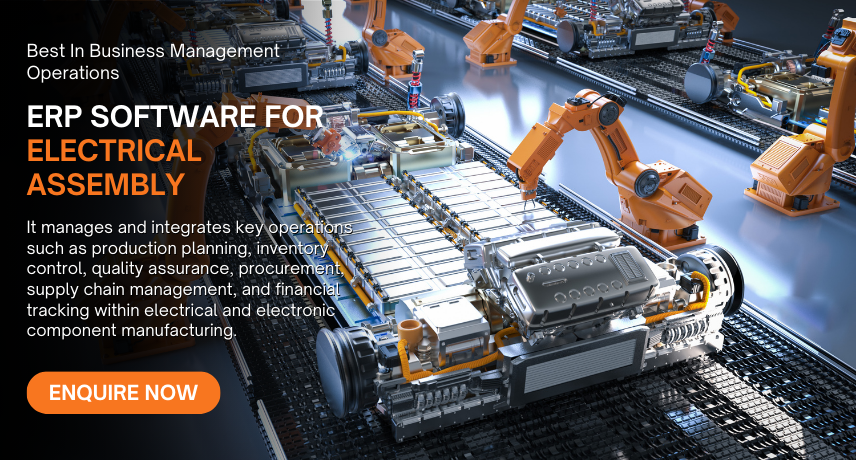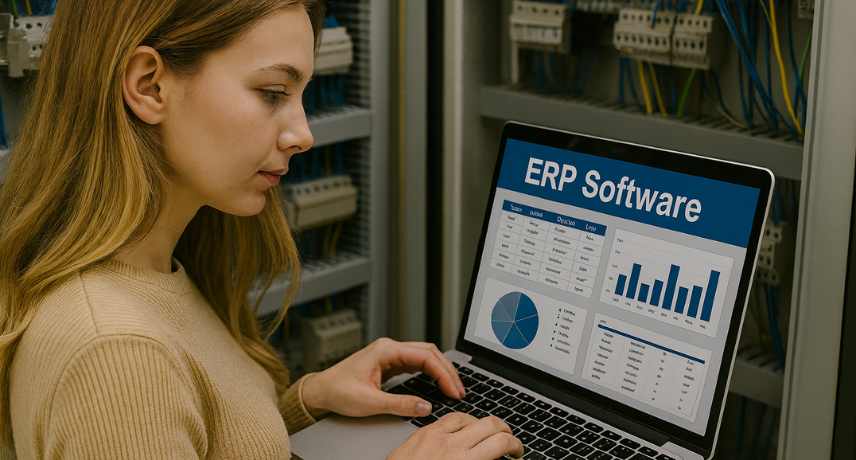Enquiry Form
What is ERP Software for Electrical Assembly?
ERP (Enterprise Resource Planning) software for the electrical assembly industry is a specialized solution that manages and integrates key operations such as production planning, inventory control, quality assurance, procurement, supply chain management, and financial tracking within electrical and electronic component manufacturing. This software ensures seamless coordination between departments, improves efficiency, reduces material waste, and enhances compliance with industry standards such as ISO, RoHS, and IPC guidelines.
What are the Best Features of ERP Software for Electrical Assembly
Here Are 15 Best Features of ERP Software for Electrical Assembly

Production Planning & Scheduling:
Automates assembly workflows, resource allocation, and work orders.

Bill of Materials (BOM) Management:
This handles multi-level product structures and component tracking.

Inventory & Material Tracking:
Manages raw materials, electronic components, and finished products.

Quality Control & Compliance:
Ensures defect tracking, testing, and adherence to industry standards like ISO & RoHS.

Machine & Equipment Maintenance:
Schedules preventive maintenance to minimize downtime.

Procurement & Supplier Management:
Automates vendor selection, purchase orders, and material sourcing.

Costing & Financial Management:
Tracks production costs, budgeting, and profitability analysis.

Order & Sales Management:
Manages customer orders, quotations, and order fulfillment.

Supply Chain Optimization:
Streamlines logistics, supplier coordination, and real-time tracking.

Traceability & Lot Tracking:
Ensures component traceability from sourcing to final assembly.

Multi-Location & Multi-Plant Support:
Centralized control for manufacturing units across locations.

Business Intelligence & Reporting:
Provides real-time analytics, dashboards, and performance monitoring.

User Access & Security:
Implements role-based access control for data protection.

Cloud & Mobile Accessibility:
Enables remote monitoring and real-time ERP access.

Integration with IoT & Smart Machines:
Connects with automation tools for real-time monitoring and efficiency.
Benefits of Best ERP Software for Electrical Assembly
- Improved Production Efficiency: Automates assembly workflows, scheduling, and resource allocation.
- Optimized Inventory Management: Tracks electronic components, wiring, and PCBs in real-time.
- Enhanced Quality Control: Ensures defect tracking, compliance with industry standards, and testing.
- Better Cost Management: Monitors production costs, waste reduction, and pricing analysis.
- Seamless Supply Chain Coordination: Automates procurement, vendor management, and order tracking.
- Reduced Downtime & Maintenance: Schedules preventive maintenance for equipment and machinery.
- Real-Time Data & Insights: Provides business analytics for informed decision-making and forecasting.
Which Businesses Need ERP Software for Electrical Assembly?
ERP software is essential for businesses in the Electrical Assembly Industry to streamline manufacturing, manage supply chains, ensure quality control, and improve overall efficiency. Below are key industries and businesses that benefit from ERP solutions

Electrical and electronics manufacturers use ERP software to manage production, inventory, and compliance.
- Production Planning: Automate production scheduling for components like circuit boards, wiring, and connectors.
- Inventory Management: Track raw materials, semi-finished, and finished products.
- Quality Control: Ensure regulatory compliance with ISO and industry standards.
- Supply Chain Coordination: Optimize procurement of electronic components and raw materials.
- Product Lifecycle Management: Manage the complete lifecycle of electrical products from design to distribution.
- Traceability & Compliance: Maintain records of serial numbers, batch tracking, and regulatory compliance.

Automotive and aerospace companies rely on ERP solutions for assembling electrical components used in vehicles and aircraft.
- Wiring Harness Management: Optimize the production of wiring harnesses for vehicles and aircraft.
- Supplier Management: Ensure the timely availability of components like sensors, batteries, and wiring systems.
- Production Cost Tracking: Monitor costs of electrical parts and assembly.
- Testing and Inspection Integration: Ensure quality control for electronic modules in safety-critical applications.
- Regulatory Compliance: Adhere to automotive and aerospace safety regulations.
- Integration with IoT: Enable real-time monitoring of smart electrical systems.

ERP software helps industrial equipment manufacturers manage the production of electrical control panels, switchgear, and automation components.
- BOM (Bill of Materials) Management: Organize components required for assembling electrical equipment.
- Project-Based Production: Plan and execute custom electrical assembly projects.
- Field Service Management: Track installation, maintenance, and service requests.
- Predictive Maintenance: Use IoT-based monitoring to prevent equipment failures.
- Inventory and Spare Parts Management: Keep track of electrical components and tools.
- Customer Support & Warranty Tracking: Manage service contracts, repairs, and warranty claims.

Solar, wind, and battery energy companies require ERP solutions to handle electrical component production and installation.
- Supply Chain Management: Optimize the sourcing of electrical components like solar inverters and battery packs.
- Project Cost Estimation: Plan and track costs for solar panel or wind turbine installations.
- Asset and Equipment Tracking: Monitor electrical components in energy infrastructure.
- Compliance Management: Ensure compliance with environmental and energy regulations.
- Order Management: Automate purchase orders for electrical components.
- Remote Monitoring Integration: Connect with IoT devices to track energy production and system health.

ERP software helps companies that manufacture and assemble home appliances, lighting systems, and consumer electronics.
- Production Workflow Automation: Automate the assembly of electronic devices.
- Component Traceability: Track every electrical component in the supply chain.
- Retail Distribution Management: Manage inventory and shipments to retailers.
- Customer Returns and Warranty Claims: Handle repairs, replacements, and customer service.
- Demand Forecasting: Predict future needs for electrical parts and optimize production schedules.
- Integration with Smart Home Technology: Support IoT-based consumer electronics with software updates and monitoring.
How to Choose the Best ERP Software for Electrical Assembly
Here Are Best Ways For How to Choose the Best ERP Software for Electrical Assembly

- Identify Business Requirements: Assess needs for production planning, inventory tracking, and compliance.
- Industry-Specific Features: Look for BOM management, component traceability, and quality control.
- Scalability & Customization: Ensure the ERP can adapt to future growth and process modifications.
- Integration Capabilities: Choose software that connects with IoT, automation tools, and existing systems.
- Deployment Model: Select cloud, on-premise, or hybrid ERP based on accessibility and security.
- Cost & ROI Analysis: Evaluate pricing, implementation costs, and long-term profitability.
- Vendor Support & Reliability: Check industry experience, customer reviews, and ongoing technical support.
ERP Software for Electrical Assembly | Automate Your Manufacturing Process ✅ Meta Description:
Enhance productivity with ERP software designed for electrical assembly businesses. Manage BOMs, streamline production, control inventory, and deliver projects on time with ease.






